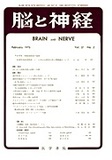Japanese
English
- 有料閲覧
- Abstract 文献概要
- 1ページ目 Look Inside
I.はじめに
進行性筋ジストロフィー症の深部腱反射が低下または消失することは古くからよく知られている。しかし,その頻度と順序についての報告はあまりみられていない1,10)。また,表在反射については正常であるとされているが,その詳細についての報告はみられない。そこで秋共は深部腱反射及び表在反射について調べ,これらと進行性筋ジストロフィー症の機能障害度との関係について検討を加えたので以下に報告する。
This report describes the frequency and order of loss of the deep tendon reflexes and superficial re-flexes in Duchenne muscular dystrophy. There are few references on the disappearance of the deep tendon reflexes and none on the superficial reflexes in this condition.
The rate and order of the loss of deep tendon reflexes (jaw jerk, biceps jerk, triceps jerk, radial jerk, knie jerk, ankle jerk, abdominal muscle jerk) and superficial reflexes (abdominal skin reflex, cre-masteric reflex, plantar reflex) was studied in sixty-one patients with Duchenne progressive muscular dystrophy. Tests of reflexes were done by usual technique, with or without reinforcement. The jaw jerk was obtained in 73.8 per cent of the pa-tients, biceps jerk in 8.2 per cent, triceps jerk in 11.5 per cent, radial jerk in 23 per cent, knie jerk in 24.6 per cent, ankle jerk in 80.3 per cent, ab-dominal muscle reflex in 24.6 per cent, abdominal skin reflex in 65.6 per cent, cremasteric reflex in 77.1 per cent and plantar reflex in 100 per cent.
The greater part of jaw jerk was preserved in ambulant phase but about two third of them was disappeared in late stages.
The biceps and triceps jerks were lost in fairly early stages, and there were no such reflexes in stage 3-4. But the radial jerk was presented in 33.4 per cent in the same stages. After the abolish-ment of walking, all of the radial jerk were dis-appeared. In the upper extremity, the biceps and the triceps were the first deep tendon reflex to be lost in spite of the fact that the function of the upper extremity was fairly preserved. In the lower extremity, the knie jerk was the first deep tendon reflex to be lost. The reflexes in the upper ex-tremity were disappeared before the reflexes in the lower extremity were lost. The ankle jerk was the last deep tendon reflex to be lost.
The abdominal muscle reflex was lost before the end of the ambulation phase. Both the abdominal skin and the cremasteric reflexes that were un-obtainable were increased in the final stages of the disease. All of the plantar reflexes were flexor.
No significant correlation was found between the presence of ankle jerk and pseudohypertrophy of triceps surae. There were no unilaterally absent reflexes except a patient with severe constructure in one side of the heel cord, who lost the ankle jerk of the same side.

Copyright © 1975, Igaku-Shoin Ltd. All rights reserved.


